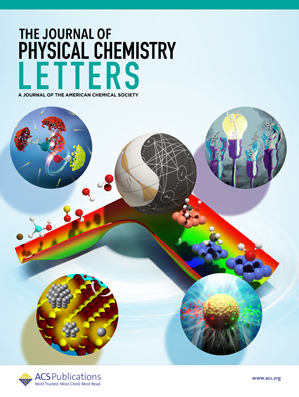揭示丙酮酸的初级光化学:直接观察三个相互竞争的通道
IF 4.8
2区 化学
Q2 CHEMISTRY, PHYSICAL
引用次数: 0
摘要
本文章由计算机程序翻译,如有差异,请以英文原文为准。

Unraveling the Primary Photochemistry of Pyruvic Acid: Direct Observation of Three Competing Channels
The photodissociation of gaseous pyruvic acid at three representative wavelengths, 369.74, 354.45, and 322.50 nm, was studied under collision-free molecular beam conditions. Kinetic energy distributions of the neutral products were measured using tunable vacuum ultraviolet photoionization followed by mass spectrometric analysis. Decarboxylation (CO2 elimination) was dominant for all three wavelengths, producing primarily ground state singlet methylhydroxycarbene, 1CH3COH, as well as a minor yield of electronically excited 3CH3COH. Excitation at 369.74 and 354.45 nm produced 1CH3COH with internal energies lying below and above the calculated potential energy barriers for isomerization to vinyl alcohol (C2H3OH) and acetaldehyde (CH3CHO). This suggests that the bimolecular chemistry of CH3COH may be important in the atmosphere. At 322.5 nm, C–C bond fission producing HOCO + CH3CO was also observed as a minor channel. While decarboxylation producing 1CH3COH + CO2 on the singlet potential energy surface (PES) is clearly dominant, observation of 3CH3COH + CO2 and HOCO + CH3CO confirms that the triplet PES also plays a role in pyruvic acid photochemistry in the actinic region.
求助全文
通过发布文献求助,成功后即可免费获取论文全文。
去求助
来源期刊

The Journal of Physical Chemistry Letters
CHEMISTRY, PHYSICAL-NANOSCIENCE & NANOTECHNOLOGY
CiteScore
9.60
自引率
7.00%
发文量
1519
审稿时长
1.6 months
期刊介绍:
The Journal of Physical Chemistry (JPC) Letters is devoted to reporting new and original experimental and theoretical basic research of interest to physical chemists, biophysical chemists, chemical physicists, physicists, material scientists, and engineers. An important criterion for acceptance is that the paper reports a significant scientific advance and/or physical insight such that rapid publication is essential. Two issues of JPC Letters are published each month.
 求助内容:
求助内容: 应助结果提醒方式:
应助结果提醒方式:


